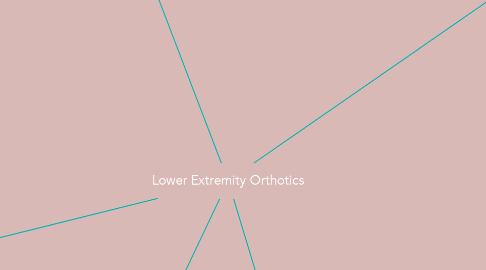
1. Purpose of Orthotics
1.1. Facilitate Movement
1.1.1. Support of weak muscles
1.1.2. Promotion of movement
1.1.3. Electronically activate muscle
1.2. Correct Postural Deviations
1.2.1. Wedges
1.2.2. ROM Range
1.3. Decrease Gait Deviations
1.3.1. Electrical Output
1.3.2. Support of joints
1.4. Reduce Aberrant Movement
1.4.1. Support of weak muscles
1.4.2. Reduce hyper-mobility
1.5. Decrease Hypermobility
1.5.1. Immobilize
1.5.2. Adjustable ROM at the joint
1.5.3. Electronically improve muscle tone
1.6. Increase Safety
1.6.1. Promote Stability
1.6.2. Wider BOS
1.6.3. Decrease unsafe compensation
1.7. Increase Independence
1.7.1. Promotes the ability to do more functions and activities
1.7.2. Safer with ADLs
1.7.3. Conserve energy to be able to perform more activities
1.7.4. Return to everyday life
1.7.4.1. Increase happiness
1.7.4.2. Better outcomes
2. Impairments that Benefit from Orthotics
2.1. Neurological
2.1.1. Stroke
2.1.2. Spinal Cord Injury
2.2. Weakness
2.2.1. Drop Foot
2.2.1.1. Weak DF
2.2.2. Foot Slap
2.2.2.1. Weak DF
2.3. Genetic Abnormalities
2.4. Developmental Issues
2.5. Spasticity
2.5.1. Spastic PF
2.6. Postural Deficits
2.6.1. Pes Cavus
2.6.2. Pes Planus
2.6.3. Hypermobility
2.6.3.1. Genu Recurvatum
2.6.4. Fixed Structural Malalignments
2.6.4.1. Rearfoot Varus
2.6.4.2. Rearfoot valgus
2.6.4.3. Forefoot Varus
2.6.4.4. Forefoot Valgus
2.6.4.5. Plantarflexed First Ray
2.6.5. Genu Varus
2.6.6. Genu Valgus
3. Length of Use
3.1. Temporary
3.1.1. Massed produced; not custom
3.1.2. Acute phases of healing
3.1.3. Orthopedic Injuries
3.2. Definitive
3.2.1. Durable and long lasting
3.2.2. Custom fit; more expensive
4. Types of Orthotics
4.1. FO
4.1.1. Insoles
4.1.1.1. Shock Absorbing
4.1.1.2. Semi-Rigid
4.1.1.3. Flexible
4.1.2. Goals
4.1.2.1. Reduce Forces
4.1.2.2. Optimize WB functions
4.1.2.3. Prevent injuries
4.1.3. Purpose
4.1.3.1. Functional Orthoses
4.1.3.2. Accommodating Orthoses
4.2. SMO
4.2.1. Assists frontal alignment
4.2.2. Assists transverse alignment
4.3. AFO
4.3.1. Solid
4.3.1.1. Ground reaction forces
4.3.1.2. Shank alignment
4.3.1.2.1. Ankle angle
4.3.2. Articulated
4.3.2.1. Requires 5-10 degrees of true DF
4.3.2.2. PF stop
4.3.2.2.1. Controls knee hyperextension in midstance
4.3.2.3. DF stop
4.3.2.3.1. Controls knee flexion in terminal stance
4.3.3. Metal Upright
4.3.3.1. DF or PF assist
4.3.3.1.1. Spring loaded
4.3.3.2. Adjustable
4.3.4. Posterior leaf spring
4.3.4.1. Positions foot sagitally
4.3.4.2. Control plantarflexion
4.3.4.3. Allow dorsiflexion
4.3.5. Energy return AFO
4.3.5.1. Assists forward propulsion in terminal stance
4.4. KAFO
4.4.1. Used in orthotic and neurological populations
4.4.2. Conventional non-locking
4.4.3. Locking
4.4.4. Stance control
4.5. KO
4.5.1. Preventative
4.5.2. Corrective
4.5.3. Genu varum/valgum/recurvatum
4.5.4. Control hypermobility
4.6. HKAFO
4.6.1. Utilizes support of Lower Trunk to Anchor
4.6.2. Blocked Hip ADD, Hip ABD, and IR/ER
4.6.3. Can be placed unilaterally or bilaterally
4.6.4. RGO
4.6.4.1. 2pt or 4 pt reciprocal gait
4.6.4.2. Full hip extension is a MUST
4.7. HO
4.7.1. Post-surgery
5. Components of Orthotics
5.1. Hold
5.1.1. Fixed position
5.1.2. Prevent 1-plane motion
5.1.3. Solid AFO
5.2. Stop
5.2.1. Prevent 1-direction motion
5.2.2. PF Stop
5.2.3. DF Stop
5.3. Assist
5.3.1. Facilitate 1-direction motion
5.3.2. Weakness/paresis
5.3.3. DF Assist
5.4. Lock
5.4.1. Prevent motion for Stability
5.4.2. Allow motion for recovery
5.4.3. Stance control KAFO
5.4.4. Drop Lock
5.5. Adjustable
5.5.1. Increase movement
5.5.2. Restrict movement
5.5.3. Modify as needed
5.5.4. Double Upright Adjustable AFO
